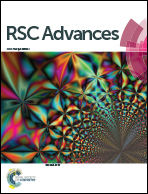A wide-range operating synaptic device based on organic ferroelectricity with low energy consumption†
Abstract
In this work, a wide-range operating synaptic device based on organic ferroelectricity has been demonstrated. The device possesses a simple two-terminal structure by using a ferroelectric phase-separated polymer blend as the active layer and gold/indium tin oxide (ITO) as the top/bottom electrodes, and exhibits a distinctive history-dependent resistive switching behavior at room temperature. And the device with low energy consumption (∼50 fJ μm−2 per synaptic event) can provide a reliable synaptic function of potentiation, depression and the complex memory behavior simulation of differential responses to diverse stimulations. In addition, using simulations, the accuracy of 32 × 32 pixel image recognition is improved from 76.21% to 85.06% in the classical model Cifar-10 with 1024 levels of the device, which is an important step towards the higher performance goal in image recognition based on memristive neuromorphic networks.



 Please wait while we load your content...
Please wait while we load your content...